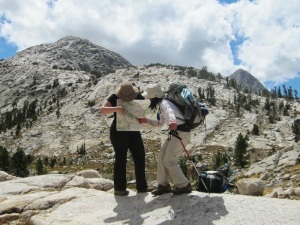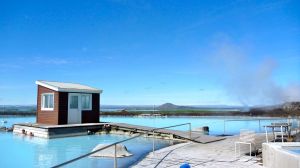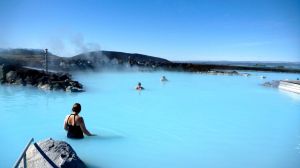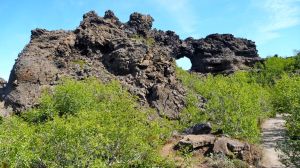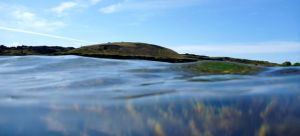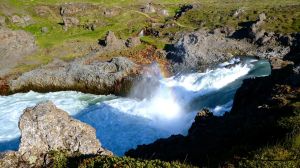Campsite: Palikū (Site has water and holds up to 25 people)
Permit: Free permits are first-come first-serve before 3pm daily from ranger stations
Mileage: Day One = 9.3 miles; Day Two = 10.4 miles
Elevation Loss/Gain: 3,360/1,620 feet
Trails: Start on Sliding Sands and return on Halemau’u (requires a car shuttle or pick up)
Map and Details: http://www.nps.gov/hale/planyourvisit/wilderness-camping.htm
In May 2012 Chris and I were lucky enough to spend a week on the Hawaiian island of Maui, and although we spent plenty of time at the beach we also made a brief two-day foray inland. What was worth deserting the Maui coastline for? A backpacking trip into the heart of Haleakalā — an ancient shield volcano whose highest peak rises over 10,000 feet above the island (also home to one of my favorite plants on earth).

Isn’t the Silversword the most beautiful plant ever?
This ~20 mile roundtrip hike 3,360 feet down into a deep depression from the southeastern side of Haleakalā’s summit isn’t for everyone. I’ve spoken to hikers who found the trip monotonous and barren with a little too much elevation change. Did I also mention there is almost a 100% chance of rain once you reach the rainforest? Personally, we loved every minute of it. What’s not to love about lunar lava landscapes, rainbow-colored sand, the transition from desert to rainforest, endangered attack geese, and a plant so rare it grows nowhere else in the world? However, it’s possible you may need to have lived in a desert landscape like Arizona or Iceland to be able to look beyond that first 4 miles of sand (/warning).

Look! My Pants Turn into Parachutes in ~50mph Gusts
What do most tourists come to see at Haleakalā? The summit at sunrise. It’s genuinely astonishing how many people and cars manage to cram into a couple small parking lots near the summit at 4am every day (get there early if you want a spot). Not that I blame them, it is pretty fun to go from a hot and humid sea level to a blanket-festooned snuggle fest at 10,000 feet in less than two hours. Plus, the sunrise can be spectacular. Even more astonishing? How empty those parking lots are 15 minutes after sunrise. We came up with the brilliant — and slightly masochistic — plan to arrive in the pitch-black pre-dawn, see the sunrise, pick up permits, and start hiking. This plan worked pretty well except for two things: 1) The rangers at the summit refused to give us a permit until 8am because they wanted to be available for the sunrise tourist crowd (they did give us the option to drive down to a lower ranger station to get a permit). 2) It was freezing with winds gusting up to 40-50mph.

Sliding Sands Trail
Luckily, the rangers relented around 7am (because everyone had already left) and let us watch the “Leave No Trace” video and fill out the permit paperwork. Unluckily, the wind was not letting up. We decided to go anyway because how bad could it be hiking on a sandy trail with wind blowing grit straight into your eyes? It was pretty funny because as soon as we put on our packs and headed out on the trail two local guys hiding from the weather in their truck gathered their courage and headed out right behind us with their backpacks. Fortunately, once we got off the summit the wind dropped dramatically.

Silverswords in their Natural Habitat on the Sliding Sands Trail
We started our hike from the summit on the Sliding Sands Trail, which zigzags 2,500 feet down a sandy slope for 4 miles. Sliding Sands is basically a steep desert, but the views of the valley and the plants that manage to survive there make it all worthwhile. There is one plant in particular that deserves a mention — the threatened and protected Haleakalā Silversword. This silvery succulent grows nowhere else in the world, lives 20 to 90 years, flowers only once in its lifetime (when it produces up to 600 maroon flowers), and sparkles like a metallic jewel in the summit sunlight. I may have a plant-crush on the Silversword.

Once in a Lifetime & Out of Season
Silverswords tend to flower between July and October, but we were lucky enough to come across a single flowering plant right next to the trail. To be honest the furry flowers are not the best feature of this sleek silvery marvel, but when you know you are seeing the only flowers that plant will ever produce they take on an increased significance. Sadly, the Silversword may be declining because of climate change.

Chris Points the Way to Paliku
Unsurprisingly, the four miles straight down go quickly and quite suddenly you hit a flat plateau of sand and rocks of a different color. Most day hikers don’t make it this far down because for some reason they are averse to the 2,500 foot climb back up, so this can be a nice lonely stretch of lava fields. The sign informed us that there were only six miles left to Palikū campsite, and we gratefully embraced the scenery and slope change.

Life in the Lava Rocks!
It’s always a surprise when life pops up in such an inhospitable landscape, and the life in Haleakalā was unusually beautiful – especially for plants that have to survive in fields of rock and sand. I was taking note of every plant I saw in the black lava fields — I may even have gotten down on my knees for a closer look at some — when we hit the next transition point on the hike and suddenly the color of the dirt changed yet again and there was grass everywhere. We were slowly approaching the rainforest and could see more green (and clouds) in our future, but before the forest came the grasslands and then shrub and chaparral lands.

From Lava Fields to Grasslands

On the Edge of the Rainforest
The closer we got to Palikū — which sits at the edge of the rainforest and the start of the next steep ascent down to the sea — the more the landscape began to change. We ran into our first cabin and campsite area — Kapalaoa — at the border between the grass and shrubby rocks. Haleakalā National Park has three bunk-equipped wilderness cabins with such luxuries as a picnic table, stove, and outhouse that you can reserve up to six months in advance ( it’s a good idea to reserve early because they book up fast), which would probably be fun with a larger group. We took a short break at the Kapalaoa picnic table before the final stretch. After the cabin, we left the flatlands for the bumpy lands and went up, down and around a series of tiny hills following a general downward slope towards the edge of the crater.

Rainbow’s End Where the Rainforest Begins
We reached Palikū and the rainforest in the early afternoon with plenty of time to explore the area. The last stretch of trail to Palikū is shrouded in greenery before opening up to a lovely tree-lined meadow where flattened grass marks established tent sites and the cabin nestles amongst the trees on the right side of the field. We were the first people to Palikū that day (spring is a nice time to go to avoid the crowds), so we got our choice of campsites. The second people to arrive were the two local guys we had been playing leapfrog down the trail with, but since they were carrying ice and beer the weight of their packs slowed them as the day went on and they didn’t get in until much later. They informed us that this was their one and only annual backpacking trip and that they were going to continue all the way down the Kaupo trail to sea level the next day.

Our Private Enchanted Glade at Palikū
We were examining a potential campsite in the top right of the open meadow when I noticed a fallen log guarding the entrance to a private glade almost completely hidden from sight (it was on the hill above the water spigot and to the left of the cabin). It was the perfect site — exactly big enough for one tent, enclosed on three sides by tasty berry bushes for privacy, just high enough to keep us out of the rainforest mud, and possessing one bench-like log as a substitute front door. We immediately set up camp in our little rainforest hideaway and settled down for an afternoon nap (to be fair we did get up at 2am that day). As we dozed it began to drizzle, which just made our campsite feel even more homey. (Note: In case you ever stay at Palikū the outhouse is on a muddy path hidden in the foliage behind the cabin on the right side before the bridge.)

What’s so cool about these geese? They’re rare geese.
Palikū is a beautiful place to spend a lazy afternoon and night as long as you come prepared for rain — keep an eye out for rainbows! We spent at least 20 minutes just watching the Nēnē — endangered Hawaiian geese — posture and guard their territory, which happened to be the lawn in front of the cabin near the water spigot. We had to wait for them to get their water first before we could fill up (yes, I may have been slightly afraid of the geese after they charged us for passing through their territory). There were signs saying don’t feed or water the geese, but I’m not sure how or why we were supposed to stop them from getting water (especially since we were in a rainforest with a creek running nearby). There was no way I was starting a territory fight with the Nēnē.

Day 2: Looking Back Towards Palikū
The next morning I was loathe to leave our little rainforest glade, but it was a beautiful day and we had a long way to go if we were going to meet my parents on time at our rendezvous point at Kalahaku Overlook. We chose that meeting point so that we could take a different trail on day two and because it meant we only had to climb around 1,600 feet instead of 2,500 back to the summit.

The Trail through Sand
We took the Halemau’u Trail on day two and it went past some amazing sites — a rock that looked like a dragon up on a cliff, a labyrinth of dead lava, rainbow-colored hills of sand, the “Bottomless Pit” featuring some of the multi-colored sand (see trail map for location), and of course the “Silversword Loop”. The short Silversword Loop was a detour of less than a mile that took us by small clusters of that most illustrious plant spread out along the trail — I thought it was definitely worth the detour and I may have taken an unreasonable number of photos. It is only with great restraint that I am limiting myself to posting a single photo here.

Silversword with a View

Approaching the Climb Out
Haleakalā National Park kindly asks visitors not to go off trail or defecate on the delicate landscape because natural processes move very slowly in this volcanic area and the damage could last decades or more. For this reason, we waited until we reached the outhouse at Holua Cabin before using the restroom and even braved the stinging insects guarding the entrance. There is very little water in this part of the park, so insects are attracted to the water spigots and outhouses.

Taking a Break Outside Holua Cabin
Holua Cabin was our last stop before the climb out, which went straight up from a flat field. On our way up, we actually met a rowdy party of locals climbing down to spend a few days partying at Holua Cabin — they lied and told us we were almost at the top after just one more bend. Liars! Never trust the people walking downhill when they tell you it’s not that far to the top.

Climbing Out of the Volcano
The climb out was needless to say a good workout, but the views as we went higher and higher got ever more spectacular which made it all worthwhile. The trail was also graded pretty nicely and it went all the way around the peninsula of rock, so we got views from both sides. It felt very satisfying to reach the top and look down to see where we had just spent the last two days looping around. I highly recommend taking a couple days from a beach-side Maui vacation to do some backpacking in Haleakalā National Park. There really isn’t anything quite like Haleakalā’s plants, animals, rocks, and views anywhere else in the world.

Celebrating the End of the Climb + Hike with a View























